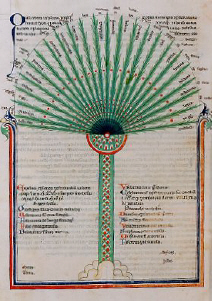To those who approach Plato’s philosophy for the first time, the most striking aspect of it perhaps is its distinctive way of seeing reality Plato’s dialogues, in particular the Phaedo, Phaedrus, Republic, and Timaeus, encourage us to visualize reality as if it were divided into two worlds, the material world that we perceive around us with our senses (the ‘sensible’ world) and an immaterial world to which we have access only by thought or intellect (the ‘intelligible’ world). The material world is subject to never-ending change. Everything in it is in continuous process: bodies are unceasingly formed and dissolved and are incapable of maintaining a stable identity. Material things are too evanescent and ambiguous for anything true to be said or known about them. The immaterial world, by contrast, is all stability, permanence, eternity. It is populated, not by bodies in flux, but by ‘Forms’ (or ‘Ideas’). These are immaterial beings possessing clear-cut and unchanging identities: the Form of beauty, for example, is beauty itself, beauty eternal, as compared with the fugitive suggestions of beauty in material things. The relation between the two worlds is such, it appears, that the material world is a shadowing forth, an imaging of the world of Forms. The material world exists only to the extent that it shares in the eternal being of the Forms, just as a shadow exists only as the shadow of something. To comprehend the world that we see, the theatre of shadows in which we live, we must discover in thought the eternal models which it reflects, the world of Forms.
In presenting the Platonic doctrine of two worlds, it is difficult to avoid suggesting what the sense of the doctrine might be. A literal reading of Plato’s visual language might take it that Plato does in fact see above or beyond this physical universe another universe, a sort of philosopher’s Eden of light, perfection, and immortality to which our souls long to escape. Another interpretation of the doctrine, warning us against taking Plato’s visual descriptions too literally, might claim that the doctrine boils down to a distinction between conceptual categories (the Forms) and the data of sense-perception. But what did Plato himself really mean to say? What is the precise sense of the distinction he makes between Forms and physical objects, between immaterial and material reality? These questions remain open even today. Many different answers have been proposed. There seem to be many ways of making philosophical sense (or nonsense) of Plato’s distinction.
The Middle Platonists do not on the whole show much originality in their approach to the subject. Alcinous presupposes a simple schoolroom distinction between two worlds, between sensible and intelligible reality, as a basic and unquestioned dogma of Platonism (see, for example, Didaskalikos, ch. 4; also Atticus, fragment 8, and Apuleius, De Platone et eius dogmate, ch. 6). Numenius discusses the subject more fully in his dialogue On the Good (fragments 3-8), but he merely embroiders on what can be found in some passages in Plato. Emphasizing the evanescence of corporeal things and the immutability of the immaterial, he insists that only the latter can be regarded as what exists in the fullest and truest sense, since it remains what it is and is not subject to dissipation as are bodies. Plotinus, however, breaks away from such platitudes in various ways. He tends to approach Plato’s distinction in the context of a distinction between soul and body. The need to avoid confusing soul with body and the discovery of intellect as the origin of soul bring us to a new way of understanding the difference between immaterial and material reality. And the problem of the relation between these two kinds of reality arises in connection with the difficult problems posed by the link between soul and body. In this chapter Plotinus’ interpretation of the doctrine of two worlds will be discussed in terms of the distinction between soul and body. The topic will be examined further in the following two chapters as regards the link between soul and body (Ch. 2) and the relation between soul and intellect (Ch. 3).
For almost 2,000 years many philosophers took for granted the Platonic belief that the visible world is the shadow of a higher, more substantial, immaterial world. Even Aristotelians, inasmuch as they believed in the existence of a superior, immaterial divine substance, came near to this view, although they did not follow the Platonists in condemning the material world to a sort of semi-existence. A decisive change and a new beginning came only in the seventeenth century, with Rene Descartes. In his effort to break away from ancient and medieval philosophy and found a new, resolutely modern philosophy Descartes took as the fundamental metaphysical distinction that between mind and body. The question whether ‘mind’ (however defined) is ‘different’ (and in what sense) from body (whatever that may be) remains unresolved and crucial in modern philosophy. To what extent did Plotinus, in interpreting the two-world doctrine as a distinction between soul (or intellect) and body, anticipate Descartes’s new beginning? Some suggestions concerning this will be made in the conclusion to this chapter.
